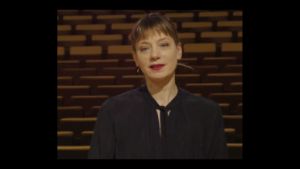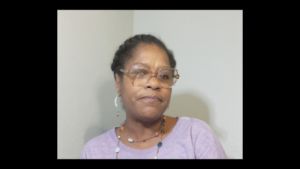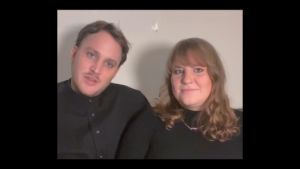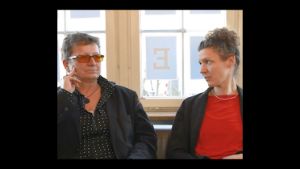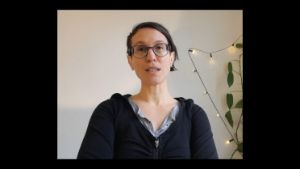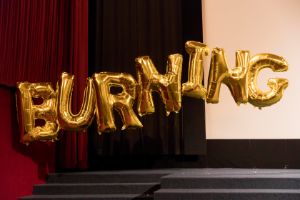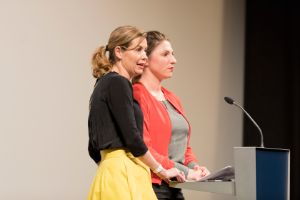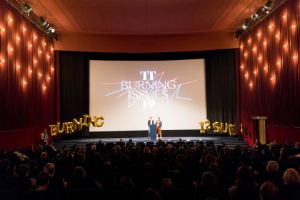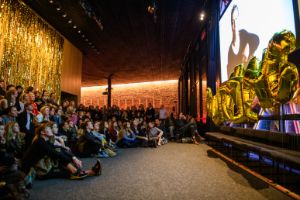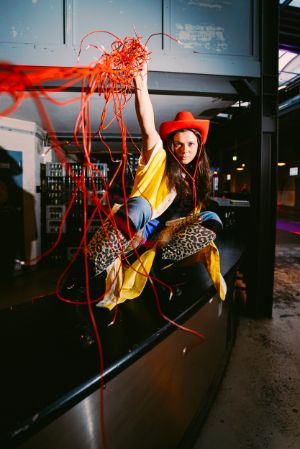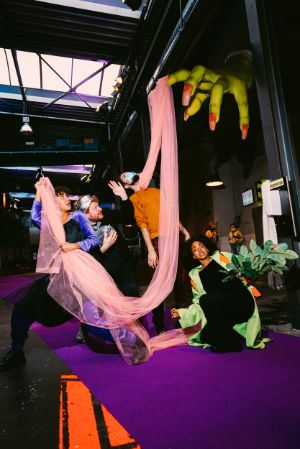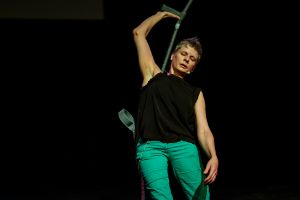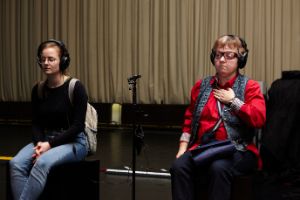Yvonne Büdenhölzer
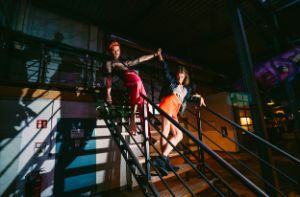
Burning Issues
© Rebecca Rütten
Providing a Platform:
Burning Issues
Performing Arts & Equity Making Voices Heard
On the opening weekend of this year’s Theatertreffen (7 and 8 May 2022), the conference BURNING ISSUES x Theatertreffen, a co-operation project with the International Theatre Institute (ITI Center Germany), will take place at the Berlin Academy of the Arts on Pariser Platz for the first time and also return to Haus der Berliner Festspiele after an absence since the 2019 festival edition.
We hope that this Digital Guide will serve to extend and consolidate the topics addressed at the conference. We are living in times of change. It seems as if the cumbersome theatre apparatus has set itself in motion. This conference and this guide are an attempt to capture some of these “BURNING ISSUES” – with no claim of being exhaustive – and to make a variety of voices heard.

Burning Issues x Theatertreffen 2019
© Eike Walkenhorst
1
BURNINGISSUESxTheatertreffen2022
Let’s talk about Power!
We rarely talk about leadership in the theatre. Tools of personnel development, structured feedback sessions, joint workshops etc. are often still derided and not taken very seriously. Many artistic directors of theatres are self-taught in matters of management and were chiefly appointed because of their artistic excellence.
These decision makers find themselves under great pressure in their work and faced with high expectations from many different sides: from the culture politicians, the audience, their employees and often from themselves. This pressure results in urgent questions such as: What is modern leadership and what exactly is “good leadership”? What skills are needed and above all: Who is needed? What does it mean to head a theatre or production house in the 21st century? How can conflicts be resolved; is this relentless pressure really necessary and how should someone in a leadership position deal with it – without losing themselves in the process?
What is Good Leadership?
The proportion of FLINTA* in executive positions is still alarmingly low. What measures are needed to facilitate greater diversity in leading positions? And which training programmes should be made mandatory for everyone who bears responsibility for their staff? The team of BURNING ISSUES has asked various theatre makers in the German-language region how leadership positions in the sector should work.
“Inequality is not a natural phenomenon. Inequality is not abstract, it is made by ideology and politics! Ideas and ideologies are a deciding factor in history. And they can be changed. We can determine what we see as social justice, a just economy. It is up to us, and the struggle for a fair society is nowhere near lost. But: We have to fight this fight! It isn’t enough to form opinions, we have to actively join the fray and get involved.“
Volker Lösch (theatre director)
Is Artistic Freedom Really Without Boundaries?
Christina Barandun
Another Get Out of Jail Free card that creative executives like to play is the much-touted concept of artistic freedom, according to the maxim: In the name of the artistic freedom, a conductor or director is allowed to get away with just about anything – throwing stands, attacking people verbally, giving free rein to their (usually negative) feelings. These central figures of a stage production can keep an entire establishment and its several hundred employees in suspense, or even in terror. Whether “stars” or not, artistic leaders are given a great deal of power under the banner of artistic freedom. And even if “artistic efforts based on collaboration” is set up as an ideal, in cases of doubt, it’s the star’s own artistic will that ultimately everyone be forced to follow. Because how would you dare to constrain the artistic process of a “genius”?
Two elements are mixed here, though – the stage work and the rehearsals, i. e. the creative process. What’s visible on the stage is one thing: the work itself should be artistically free, even though this freedom is necessarily restricted by various fundamental rights, such as the inviolability of the individual.
The creative process during rehearsals is quite a different matter. Artistic collaboration is clearly subject to the provisions of health and safety at work, and here the stipulation that the mental health of employees must not be put at risk applies. The work process and the protection of the physical and, above all, mental health of workers must not be undermined, even in artistic enterprises.
Abuse of Power in the Theatre Industry
The Basics
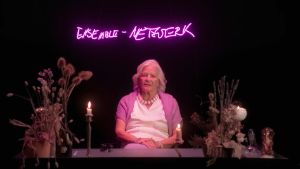
Abuse of Power in Theatre
© ensemble-netzwerk
Is culture going overboard with cancel culture?
Two opinions
Birgit Walter
Yes: When Suspicions Destroy Careers
In late March, artist Ronja Maltzahn was banned from performing at a Fridays for Future-event because her hair-style is wrong. By wearing dreadlocks, so the reasoning, she appropriates a foreign culture without having gone through its oppression. Cultural appropriation as a charge! As if that weren’t the basis of the world’s culture – music, fashion, architecture: it was all appropriated at some point. And this exclusion came from a group that we had hoped would be the one to focus on the essential struggles.
Antigone Akgün
No: Who Is the Subject of This Discussion?
Cancel Culture – it’s a dreaded term, a political buzz-word that suggests the establishment of a common practice, a new form of culture. “But where will it end, except in the demise of error friendliness and the targeted eradication of individual careers?” some outraged critics are saying. And how can alleged “faux pas of a private nature” even be considered exemplary for a person’s work ethos?
2
BURNINGISSUESxTheatertreffen2022
About a Contemporary Approach to the Dramatic Canon
What would a season’s programme be without the classics, without “Faust”, “The Robbers”, “Mary Stuart” or “Hamlet”…? Would there be fewer visitors? Would the subscriptions drop, would school groups henceforth avoid a trip to the theatre, the veritable venue of high culture? And: which materials and texts would be left? Should we really erase the so-called German canon and never show any of its plays again? Or isn’t the task rather to rewrite, to rethink it?
Sooner or later, all these question lead us to the discourse about cultural identity – to the questions of what holds a “nation” together, which stories have been told across the centuries and what kind of consciousness, of identity has been their result. When we ask who came up with these stories many years ago, the answer is quite simple: well-educated White men.
Particularly among the younger generation of dramatists, we see the wish to challenge the canon in their writing, to turn it inside out and to question it critically from a contemporary perspective. The authors’ attempts and approaches are as varied as their individual points of view. And this diverse image of perspectives finally begins to somewhat reflect the diversity of today’s society.

Burning Issues
© Rebecca Rütten
Why Peer?
Maria Milisavljević
Why “Peer Gynt”, again? Why not something new, something diverse, something courageous, something that has not yet been done? This author is complaining even though things are going pretty well: I’ve been offered my biggest commission yet. Finally: a theatre text for the main stage. This is a rare opportunity for me as a young author of nearly 40 and more than 20 years of theatre. Finally, the first commission for the big stage, the very biggest stage. There will be 500 people in the auditorium. I’m a pragmatist and this means that if everything goes well and the pandemic turns out to be favourable and everything goes to plan at the theatre and the piece is performed more than ten times (which is rare for new texts) – then this number of “500” means that four-figure residuals may be expected on top of the fee. So this means that a) I will finally and for the first time have a commission which recognises that this is how I make a living and b) we are finally moving on after the pandemic .
My first big commission arrived: the main stage and a fee that was actually going to allow me to pay my bills. But how did it come to this? The theatre had decided that there were too many men in the season’s programme and when the director suggested “Peer Gynt”, it was clear that it was going to be a rewrite. By a woman. And Peer would also be a woman. The homage to Mr Ibsen remained in place. And I will stick to the answer that I gave an older gentleman during an audience talk when he asked why it was necessary to adapt an Ibsen-text: “Would you have come to the theatre if MILISAVLJEVIĆ had been played on the main stage?” No, and neither would you go to see an experimental story that sounds a little post-migrantic on the studio stage. So, what should I do? To get you to listen to me?
So, we take the Ibsen and we squeeze out everything that is important for the things that we want to say. I’ve done this before, and with his “Enemy of the People”, I got into a little trouble with an oil magnate called Irving in Eastern Canada. The play ended up dealing with fracking, which he likes to do in that region – and it turned out that he owned the theatre in which it was performed. So the text had to be rewritten with no mention of oil, but using gold instead. Okay, so it was gold mines that polluted the waters of the nearby reservation. The message was still delivered. Mr Ibsen – because, again: who would have wanted to see a MILISAVLJEVIĆ in Eastern Canada? – had served his purpose.
About Heartfelt Wishes, Solidarity and New Possibilities
Katja Brunner
Katja Brunner talks about solidarity among persons read as female and about the questions of how loud the beating of her feminist heart is and what she would like to see in a debate about the dramatic canon. Listen now
Tothe transcript (pdf, 106 KB)
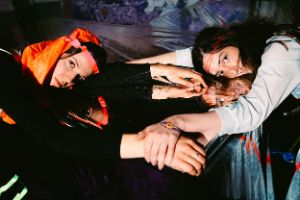
Burning Issues
© Rebecca Rütten
Archival Work in Transition
Anna-Katharina Müller in conversation with Sara Örtel
Dear Sara, who are you and what is your field of work at the Akademie der Künste (Academy of the Arts)?
Sara Örtel: I am a research associate for the Performing Arts archive at the Berlin Academy of the Arts, where I am in charge of Production Documentation. Unlike documents about persons, which constitute a focal point of the archive’s profile and often reach us in the context of legacies, the documentation of productions have a closer connection with the present: It is a curated selection; we agree on a written documentation of rehearsals and request material. This happens before rehearsals have even begun, only on the basis of the title and the creative team. Our aim is to have someone in the production team document it, because any additional outside person could endanger the intimacy of a protected rehearsal room.
How do you decide which production should be documented?
This decision is made by the head of the department and myself, in consultation with members of the Academy’s section for Performing Arts. Our budget allows for eight to ten production documentations per season. Even if we are guided by the credo of operating a representative and exemplary collection, this is a very small number of documentations for the German-language region. That is why there is a collecting focus on directors’ individual signatures. Our aim is to capture working methods or special aesthetics which leave a mark on the theatre landscape, and to describe how they are created during the rehearsal process.
“This edition of Burning Issues will remain burning until change is achieved. It will not quickly turn to ashes, nor become shadowed by new fashions of discourse, because equity can also be a way of gathering our forces to establish a common vision and practise of justice, instead of dispersing and fragmenting our efforts. Equity can be our journey towards local, regional and transnational progress in all sectors of the performing arts.”
Nora Amin (dancer, choreographer and author)
3
BURNINGISSUESxTheatertreffen2022
One Stage for Everyone – Inclusive Casting Policies
Who exactly makes theatre and for whom? Whose stories are told, which kinds of lived realities are made visible, who even has access to these venerable halls and who is refused admittance? These are urgent issues with regards to structural ableist discrimination which still and consistently happens at the theatre. Building structures, a lack of sign language interpretation, websites that are not barrier-free etc., etc. etc. … it is a long list.
Of course, it is also necessary to make underrepresented points of view visible onstage, to change viewing habits, to promote the removal of barriers, to enable inclusive access onstage, backstage and in the auditoria and to allow the theatres to become places where the stories of many different people with many different perspectives are told. But shouldn’t our route take us beyond barrier-free accessibility? Shouldn’t we aim for co-determination in executive structures and inclusion in all areas of creative production?
10 Items on the Way Towards a More Inclusive Theatre
Lisette Reuter
Remove the Barriers in People’s Minds
The theatre scene is ruled by unease and ignorance when it comes to inclusion with regards to people with disabilities and the potentials this entails. There must be a fundamental change in the mindset of cultural institutions; people with disabilities must be recognised and acknowledged as users and makers of culture.
Appreciation of Differences
All people should have an opportunity to express themselves as artists in a world that appreciates differences as valuable. For the theatre, this means that we must challenge established concepts of body, space and society in order to allow an expansion of customary criteria in contemporary culture.
Diversity-Oriented Development of Organisations
This requires the continuous availability of barrier-free options in art and culture as well as comprehensive, diversity-oriented organisational development in theatres with the aim of rendering the cultural landscape structurally and sustainably inclusive. After all, inclusive access is an added value for the entire audience and the entire structure of cultural operations.
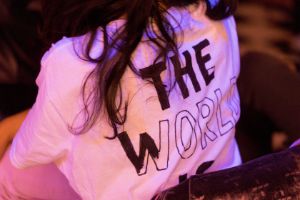
© Eike Walkenhorst
Why We Don’t Need an Inclusive, But an Anti-Ableist Theatre
Noa Winter
The label “Inclusive Theatre” often stands for productions or programmes where people with and without disabilities or deaf and hearing people perform together. But let’s be honest: In how many of these productions, festivals or companies are people with disabilities or deaf people placed in positions of power or decision making? While you are reading or listening to this text, consider how many performances featuring disabled or deaf artists you can remember watching? And in how many of them were these artists part of the directing team rather than just performers?
Your answers to these questions will probably not be unique. In 2021, more than half of the respondents from the cultural sector (52 percent) of the study “Time to Act – Wie mangelndes Wissen im Kultursektor Barrieren für behinderte Künstler*innen und Zuschauer*innen schafft (How a lack of knowledge in the cultural sector creates barriers for disabled artists and spectators)” [3] assessed their own knowledge of the work of disabled artists as poor or very poor. Only 16 percent stated that they had a good to excellent knowledge – despite the fact that there are more projects labelled as inclusive every year. I would like to take this imbalance as an opportunity to address new ways of thinking and acting necessary to ensure that disabled or deaf artists are able to work with equal rights and self-determination in the theatre sector (both at state and municipal theatres and within the independent scene). The following seven points serve as an outline.
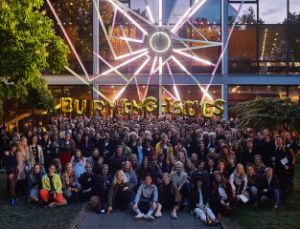
Burning Issues x Theatertreffen 2019
© Piero Chiussi
PERFORMING ARTS & EQUITY
Contributors
Antigone Akgün
Antigone Akgün is a freelance performer, author and dramaturg. Since 2017 she has been a juror at the Berliner Festspiele’s Theatertreffen der Jugend. This year she is taking over the conception and editing of the Theatertreffen blog together with Ozi Ozar.
Christina Barandun
Christina Barandun is a theatre scholar and consultant for occupational health management in theatres.
Katja Brunner
Katja Brunner is a playwright and performer. In addition to her own plays, Brunner works continuously with the playwrights’ collective “Institut für chauvinistische Weiterbildung” and writes essays for newspapers and magazines.
Maria Milisavljević
Maria Milisavljević is a playwright, freelance dramaturg and translator. She is a co-founder of theaterautor*innen-netzwerk.
Sara Örtel
Sara Örtel is a research associate at the Akademie der Künste Berlin. She is a founding member of the Frankfurt performance collective Arty Chock and worked as a dramaturg at the Deutsches Theater Göttingen from 2014 to 2018.
Lisette Reuter
Lisette Reuter is founder, executive and artistic director of Un-Label Performing Arts Company, www.un-label.eu.
Birgit Walter
Birgit Walter is a freelance writer. After studying journalism, she worked for more than 30 years as an editor in the culture section of the Berliner Zeitung. She received the Theodor Wolff Prize and the Journalism Prize of the German Cultural Council.
Noa Winter
Noa Winter works as a freelance curator, dramaturge, workshop leader and project coordinator, among others for the project “Making a Difference”. In addition to managing the production of various festivals, she has taught at the University of Mainz and is currently writing her doctoral thesis on the self-determined working methods of disabled artists and aesthetics of access
